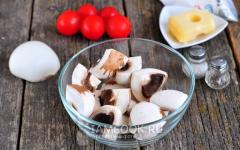Just a couple of pinches of piquant spices can completely transform any dish. But only under one condition: if you choose the right spice. This is not easy, since today there is a great variety of herbs and spices, and each manufacturer strives to present both traditional and unique seasoning options to the market.
High-quality spices and seasonings are always quite expensive, but due to the fact that they are added to dishes in minute quantities, even a small jar will last for a long time. Here, as with any other aromatic product, the higher the quality, the less quantity is required.
In order not to be mistaken in choosing spices for different dishes, keep this reminder for yourself and cook for your pleasure! And if you like some seasoning, click on the picture or name and go shopping.

Spices for meat

Paprika differs from red pepper in its mild taste: this spice is less spicy and sweeter. This is due to the fact that seasonings are made from different varieties of red pepper: paprika - from mildly hot ones, ground red pepper - from bitter (hot) varieties of pepper.
Santa Maria “Smoked Paprika” goes well with all dishes; the bright taste of paprika will be especially good for minced beef and pork and grill sauces. Adds a smoky flavor to prepared dishes and salads. Added to meat, fish, liver, poultry and vegetable dishes. Used for pickling and canning. The seasoning can also be used to make barbecue sauce.
Kotanyi Beef Seasoning is a perfectly balanced blend of pepper, garlic, oregano, turmeric, basil and rosemary that adds a wonderful spicy, peppery flavor to beef dishes. Rub the meat thoroughly with the seasoning and let it soak for a while.
Ideal for preparing beef steaks, as well as veal, lamb and pork dishes.
Dry marinades have a richer texture and new, interesting aromas and flavors.
Black pepper, parsley, citric acid and cumin in the marinade go well with lamb dishes. Use when preparing shish kebab, lamb ribs and cutlets.
Origin of spice: paprika
Paprika is native to South America. The spice was brought to Europe by Christopher Columbus, calling it “Indian red salt.” Since ground red pepper was too expensive and therefore available only to kings and nobles, paprika powder became very popular among the people. Paprika began to be grown in Europe, especially in Hungary, Spain and Turkey. However, due to the insufficiently hot climate, the plant lost some of its pungency and acquired its well-known sweet taste.
Spices for poultry

Crispy fried chicken made on the weekend is a traditional meal for many families. Wings, breast or whole chicken - Widow Bolte's Seasoning is perfect!
To achieve the most vibrant taste, you can do this: pour olive oil over the meat, sprinkle with seasoning and leave for 20-30 minutes. Paprika, garlic, rosemary, thyme and coriander add a spicy kick, while lemongrass adds a fresh note.
To add a richer flavor, mix the seasoning with a little olive oil and leave the chicken pieces to marinate for 20-30 minutes. Ingredients: sweet pepper, rosemary, thyme, garlic, lemongrass, sea salt, coriander, black pepper.
Kotanyi chicken seasoning is a harmonious combination of the aromas of paprika, pepper, marjoram and rosemary for preparing chicken and other poultry dishes. Dishes prepared with this seasoning will acquire an appetizing crispy crust.
The mixture is good for cooking according to classic recipes: for frying poultry, steaming or cooking in the oven.
Rub the poultry pieces thoroughly inside and out with this seasoning to give your chicken, duck or turkey a delicious crispy coating.
If you want to surprise your family with something exotic, the traditional Indian seasoning “Tikka Masala” will help you. The sweet-spicy flavor of chicken or turkey is best balanced with unleavened rice or vegetables.
Santa Maria Tikka Masala seasoning is a traditional Indian spice mixture suitable not only for preparing chicken dishes, but also meat, fish and vegetables.
Spices for fish and seafood

Oriental curry seasoning is a mixture of spices with a turmeric base with a bright spicy aroma and rich color.
Contrary to popular belief, the classic seasoning originally from India goes much better with fish rather than meat dishes. Curry will give the fish a tart, sweetish taste and a golden hue.
You can also use it to add flavor to rice, vegetables, meat and poultry, and seafood. The most popular dishes using curry powder are chicken salads, stews, sweet pilaf, chicken spaghetti, minced meat and meatballs.
Santa Maria Curry seasoning contains turmeric, coriander, cumin, fennel, fenugreek and several varieties of pepper. There is no salt in this mixture.
Give your dishes a magical aroma, a slight sweetish taste and a charming golden hue.
Santa Maria seasoning with a rich lemon flavor and aroma. This mixture of herbs and citric acid will help reveal and enrich the flavor of fish and seafood. “Kislinka” is well suited for river fish, such as pike perch, carp and pike, as well as shrimp.
It goes well not only with fish, but also with vegetables and salads, for example, seafood.
The sweet-spicy flavor of traditional Japanese teriyaki seasoning makes an excellent dressing for seafood salad. The spice is also good for any type of fish and fish soup
Santa Maria Japan Teriyaki goes well with vegetables, fish and meat, and is suitable for dishes cooked on the grill or open fire. For the marinade, combine the seasoning with soy sauce, ginger, lemon juice and zest. Great for Asian salad dressings.
Origin of spice: curry
The word “curry” is believed to be of Tamil origin and means “sauce.” English colonialists brought this spice to Britain from South India. Although curry is better known as a powdered spice around the world, in India curry sauce is usually liquid in consistency and prepared from fresh ingredients just before eating. There is no single recipe for curry - in India, for example, it can include up to 30 different products. The essential common ingredient in all curries is turmeric root.
Spices for soups

A classic among seasonings and an essential component of any soup. Pepper always gives the broth a rich, deep taste. A convenient “mill”, which has two degrees of grinding, finely grinds the peppercorns, so that no one gets a bitter ball on their plate.
Kotanyi 4 Pepper Seasoning is a real culinary treasure! Bright, spicy, with a great aroma, this pepper mixture is ideal for both seasoning and garnishing a variety of dishes.
You can add mushroom flavor to the broth without adding fresh mushrooms. A mixture of dried whites with parsley and garden savory will refresh and add new notes to tried-and-true recipes. The spice is well suited for vegetable soups.
An exquisite mixture of porcini mushrooms and aromatic herbs will improve the taste of meat and vegetable dishes, as well as sauces, salads and soups.
A reliable companion to your culinary adventures for over 50 years, Vegeta seasoning continues to be one of the most famous Croatian products, without which it is almost impossible to imagine cooking. The scope of application of this combination of dried vegetables and spices is not limited: from vegetables, to meat, to side dishes, to anything on the grill, to minimalist dishes, to complex deli dishes - one teaspoon of Vegeta seasoning is always enough to taste the subtle difference. Therefore, when preparing food, give freedom to your imagination and enjoy - many more new Vegeta seasoning combinations are waiting to meet you!
Spices for side dishes

Mashed, fried and boiled potatoes will turn out even more appetizing with seasoning selected specifically for potato dishes. A mix of parsley, rosemary, paprika, onion and garden savory will add a new taste to the usual side dish. And sunflower petals and marigolds will decorate the dish.
For a more flavorful dish, add seasoning at the end of cooking.
Mediterranean herbs are dried in a special, gentle way. Thanks to this, the typical Italian alluring aroma is revealed during cooking and even simple dishes acquire an exquisite taste. These dried Italian herbs will turn any boiled rice into almost ready-made risotto, and pasta into pasta. Basil, marjoram, thyme and sage will reveal the multifaceted taste of the dish. All you have to do is add cheese and tomatoes, and you are in Italy!
Garlic seasoning with herbs is good both for dishes made from fresh vegetables and for salad sauces based on yogurt, sour cream, cream cheese and cream. Mix the spice with sour cream or Greek yogurt and the spicy sauce is ready.
The mixture will also enrich the taste of grilled or steamed vegetables and go well with meat, fish, poultry and salads.
Spices for grilled and wok dishes

Sugar, turmeric and ginger in the composition will help make any Asian dish authentic, be it noodles with chicken and vegetables or rice with shiitake mushrooms.
Wok Seasoning is a blend of savory herbs and delicate vegetables specially formulated for wok-cooked dishes.
Ideally selected herbs and spices will give poultry dishes a piquant spicy taste and an appetizing orange-red color.
Hot-sweet seasoning with pepper and paprika is great both for marinating poultry and for adding directly during grilling. Chicken kebab, fillet steak and lula kebab - all chicken delicacies will acquire “that same” desired taste.
The diabolo spice is designed specifically for those who like it “hot.” The delicate taste of carrots, parsley and parsnips is slightly smoothed out by the abundance of black pepper and paprika. You can also add the seasoning to ketchup to create a spicy tomato sauce.
To make homemade wok dishes taste as close as possible to the original, it is not enough to buy a large deep frying pan. Plenty of oil and a special wok mixture are your key to success. Brown with
Baking Seasonings

Ground pepper is the most popular spice and comes in different types: black, white, green. The fruits of the future spice grow on pepper vines and, after ripening, acquire their characteristic shade. Ground pepper is considered the most fragrant, right before cooking.
Types of pepper
List of all colored peppers:
- The black variety has a bright, pungent taste. It is found on the market in crushed, whole form. Suitable for many vegetable and meat dishes. Helps improve digestion.
- The green variety has an unusual smell, fresh, pleasant taste. Sold in several forms: ground, peas, canned. Suitable for liver, pork, veal and lamb dishes.
- White pepper is rich in essential oils and improves the functioning of the gastrointestinal tract. In cooking, used for meat products.
- Sweet pink pepper is suitable for white and red meat. Sold in whole, crushed form. The taste is reminiscent of coriander seeds.
- Red pepper is a spice made from fully ripened vine fruits, used to decorate ready-made dishes, and has a very pungent taste.

"Know!" Red pepper is often confused with pink pepper, however, they are two distinct spices in terms of cost and intensity of flavor.
What spices are suitable for rabbit and chicken?
Chicken can be cooked in many ways, each with its own set of spices. The taste of white meat is varied by peppers of various colors, basil, sage, curry mixtures, and ginger. For grilling, choose turmeric for aroma and golden color. Dried oregano goes well with minced chicken.
To cook chicken in the oven, use a mixture that includes black pepper, thyme, and garlic. For marinade, soft chicken kebab, a successful combination is obtained with paprika, pomegranate juice, coriander seeds, and turmeric.

There are seasoning mixtures for wild birds:
- bay leaf, juniper fruits, thyme, a little parsley;
- celery, lemon balm, marjoram, fresh mint;
- a little orange peel, myrtle, a sprig of rosemary.
To cook a rabbit on the grill, marjoram, basil leaves, bay leaves, pepper, vinegar, and ginger are added to the marinade.
Spices for beef
The selection of dried herbs and ground spices for beef is huge. Everyone can select herbs on their own. The most popular are peppers, coriander, nutmeg, turmeric, basil, mustard seeds, thyme, and other spices.
"Attention!" When frying, add spices as soon as the crust appears and the color of the meat appears and the juices are sealed. When stewing, spices are added at the last stage of cooking.
Chili, basil, egstragon, rosemary branches are suitable for fried beef, but not all of these spices are compatible with each other. Ground paprika loses color when fried; use only when stewing. It is not recommended to combine bay leaf with rosemary, or sage with any other spices. To stew without tomatoes or tomato paste, use a little spice.

Other spices for beef:
- Cumin seeds have a distinct odor and are used for chicken and lamb.
- Cardamom is a spice that is combined in oriental dishes with pork, lamb, and poultry.
- Cumin grains have a sweet, pungent aroma and go well with liver, lamb, and white meat.
- Cloves are a spice with a sweet aroma and are used in many vinegar marinades.
- Cinnamon is a rich, sweet seasoning suitable for all types of red meat.
- Ginger root - enhances the taste of chicken and red meat, and is used in many Asian meat dishes.
- Turmeric is a hot spice, with sourness and a little bitterness. The spice adds color and unique taste to various stews, marinades, pork, and sauces.
- Anise comes in powder and whole form and is common in Eastern and Indian cooking. It is added when frying dishes in deep frying pans, preparing marinades and sauces.
- Tarragon - available in fresh or dried form, has a fresh, light aroma. Complements the taste of lamb, beef, poultry.
"Know!" Some spices can not only flavor, but also soften meat. For example, mustard seeds.
Add richly flavored oregano or marjoram to meat with vegetables and tomato paste. The dish will be spiced with cloves and hyssop (a somewhat bitter but aromatic spice). In marinades for beef, combine barberries, thyme, peppers, rosemary.
Other types of pepper:
- Cayenne pepper is made from the seeds of chili peppers. It has a bright, red hue and a strong pungent taste. Sold dry, fresh. Suitable for white meat and pork. Has the property of accelerating blood circulation in the body.
- Chili is a Mexican and oriental, popular seasoning. At the market you can find fresh peppers or dried whole, crushed chilies. It has medicinal properties - it eliminates pain. Improves the taste of stewed lamb and veal.
- Sweet red paprika - has a bright color, combined with many herbs in marinades for various meats and minced meat.
- Allspice – presented in whole peas, has a bright aroma. Suitable for soups, marinades, and any meat dishes.
Seasonings for pork
For any method of cooking pork, black pepper, sweet red pepper, a mixture of hops and uneli, and coriander seeds are used. Oregano is added to broths; for cooking in the oven - turmeric, tarragon, red hot and sweet peppers, mustard seeds, dried garlic, basil, lovage. These herbs can be used in combination to prepare a delicious dish. In mixtures with pork, sumac is used - a sour seasoning, without a special smell, but with a pleasant taste, cumin - also a seasoning with sourness.
When cooking pork in the oven, for flavor and softness, brush it with chopped basil, marjoram, rosemary, and garlic. When stewing, it is recommended to use seasonings that are on hand in every kitchen: ground pepper, bay leaf, garlic. Fresh cilantro is added to the jerky.
"Attention!" In Asian countries, pork is cooked with added sugar, which gives a golden crust and a sweet aroma.
BBQ pork marinates for 10 minutes. Place onion cut into rings into the marinade. The approximate composition of spices for the marinade includes:
- cumin seeds;
- coriander;
- black pepper;
- thyme.
Seasoning mixtures for meat
Mixes of ready-made seasonings for any meat are sold on the market, but fresh, aromatic seasoning can be prepared at home. A mixture of spices in the following proportions is suitable for the marinade:
- ginger root – 3 cm;
- a little cumin;
- sweet red pepper and coriander - 2/2 tsp;
- ground chili – 0.5 tsp.

For chicken, a combination of turmeric and thyme is used - 0.5/2 tbsp. l., curry, coriander seeds - 1.5/1 tbsp. l. To cook 1 kg of meat, use ½ tsp. mixtures. For any method of cooking beef, a combination of three different types of peppers is suitable - 0.5 tbsp. l. and rosemary – 0.5 tsp. For frying, baking pork meat, take dried carrots and parsley, greens - 2/1 tbsp, black peppercorns - 9 pcs., coriander, red sweet pepper - 1/1 tbsp. l, a little salt, rosemary.
For a bouquet garni - several types of dried spices tied together, use 2 bay leaves, thyme and parsley sprigs - 2/2, leeks - 1 leaf. Herbs are used in European dishes: soups, marinades, main dishes with meat.
Turkey Seasonings
Tender turkey carcass or parts can be boiled, stewed, fried and combined with the same foods as chicken. The meat does not have a bad smell, does not need soaking or additional flavors. But for variety, you can use some spices with the turkey.

"Attention!" Herbs with a pronounced aroma are better suited for wild birds: marjoram, thyme, sage.
For boiled carcass and broth you need a minimum of spices: peppers, thyme, rosemary. For cooking in the oven, use parsley in any form, coriander, curry, cinnamon, cloves. Soy sauce and ginger are suitable for creating oriental dishes.
It would be fair to include all spices as seasonings for meat. Which is understandable, since meat is prepared in all national cuisines and with their favorite spices.
Let's give an average set of spices for meat, suitable for most European cuisines (gourmets, forgive me!).
All types, rosemary, mustard seeds (root and greens), leushten, arugula, lemon balm, cardamom.
Spices for beef
All types of peppers, cumin (cumin), basil, sage, coriander.
Spices for lamb
Black, red and allspice, cumin, bay leaf, basil, rosemary, mint, cloves, tarragon, marjoram, caraway, sage.
Offal (offal) is usually flavored with anise, bay leaf, peppers, tarragon, thyme, sage, marjoram, oregano, dill, parsley, coriander.

About spices, fried meat and more
Interesting data was obtained by specialists from the University of Kansas (USA). They have proven that meat seasonings such as rosemary and Chinese reduce the risk of cancer in fried meat lovers.
The International Agency for Research on Cancer believes that frying meat at high temperatures produces heterocyclic amines, which are classified as "probably carcinogenic." Antioxidants, present in large quantities in the three spices listed above, prevent the formation of these substances. The spice rosemary provides the greatest protection.
According to the Health Day News magazine, the meat spice turmeric contains substances that prevent the formation and promote the resorption of existing amyloid plaques in the human brain, preventing the development of senile dementia.
Let's summarize.
When preparing meat dishes, we select spices and seasonings for meat that we love, and do not skimp on herbs. When frying meat on the grill or in a frying pan, add rosemary, ginger and turmeric.
About specialized sets of seasonings and spices for meat
There are a lot of such sets and, if they are prepared professionally (that is, made by a good manufacturer), then the meat will probably turn out delicious. However, we mean that for spices collected in a bag, the rules are grossly violated
step by step recipe with photos
The smell of store-bought ground spices cannot be compared with what is formed when grinding in a mortar. If you need to grind seasonings into a fine paste, it will be an ideal assistant. The container should be filled no more than a third full.
Bright paprika will give the pork an amazing color, and amber mustard seeds will add a piquant bitterness. Rosemary is a classic spice. The camphor note introduced by rosemary will remind you of the smell of pine.
Spices intended for grinding should not contain lumps. The aromatic mixture will give the meat an unforgettable aroma and form a light crispy crust.
Compound

- 0.5 tsp. mustard seeds
- 0.5 tsp. multi-colored peppercorns
- 0.5 ground dried garlic
- 0.5 tsp. ground paprika
- 2 pinches of ground red hot pepper
- 0.5 tsp. dried rosemary
- 1 tsp. salt
Preparation
 1. You can supplement the list of seasoning ingredients by adding other spices to your taste. Pour colorful peppercorns and mustard seeds into a mortar. At this stage, you can replace these spices with ground ones - if desired.
1. You can supplement the list of seasoning ingredients by adding other spices to your taste. Pour colorful peppercorns and mustard seeds into a mortar. At this stage, you can replace these spices with ground ones - if desired.
 2. Add dried rosemary leaves - you only need a little of them to highlight the sweetness of the pork meat.
2. Add dried rosemary leaves - you only need a little of them to highlight the sweetness of the pork meat.
 3. Mash everything thoroughly in a mortar, crushing all the peppercorns.
3. Mash everything thoroughly in a mortar, crushing all the peppercorns.
 4. Add ground dried garlic.
4. Add ground dried garlic.
 5. Follow with a few pinches of hot ground pepper. Be very careful at this stage - hot pepper is merciless when it gets on the mucous membranes, and even 1 pinch of this spice causes a real fire in the mouth.
5. Follow with a few pinches of hot ground pepper. Be very careful at this stage - hot pepper is merciless when it gets on the mucous membranes, and even 1 pinch of this spice causes a real fire in the mouth.
 6. Next, add ground paprika - it will add sweetness and velvety taste.
6. Next, add ground paprika - it will add sweetness and velvety taste.
 7. The last ingredient for preparing the spice will be coarse sea salt.
7. The last ingredient for preparing the spice will be coarse sea salt.
Even a novice housewife knows that not a single meat dish will be truly tasty without the addition of spices and herbs.
The main thing is to know which spices are suitable for this or that meat. After all, incorrectly selected spices can ruin the taste of the food.
Beef is perhaps the most picky meat to flavor. Almost any spice goes well with it. But there are some nuances here too.
Young beef is soft and tender meat. It cooks very quickly, so it is most often used for frying. Moreover, they try to fry the tenderloin as a whole piece to preserve its juiciness and taste. Old meat is tough and therefore suitable for stewing and boiling. Therefore, when choosing spices, the method of heat treatment is first taken into account.
What seasonings are added when cooking beef?
Beef is cooked with a minimum amount of spices and herbs so as not to drown out the natural flavor of the meat.
If meat is boiled to obtain broth, then only white roots are used - parsley, celery, onions, as well as carrots to give the broth a beautiful yellowish tint. Spices include peppercorns, bay leaves, and dill. The same spices are also used for cooking meat, which will later be used for salad, appetizers or filling pies.
If you want to cook soup or borscht using meat broth, then the list of seasonings can be much wider. It all depends on the recipe itself and what national cuisine the dish belongs to. For example, if you are preparing ordinary rice soup, then the classic set of spices and herbs is added to the broth - carrots, onions, bay leaves, pepper, parsley.
But if you cook Georgian kharcho soup, then at the end of cooking the dish you add suneli hops, garlic, and hot pepper. Or they replace Georgian seasoning with spices and dried herbs that are included in it. Moreover, it is not necessary to put the entire bouquet of spices, because it is quite large. These are basil, coriander, marjoram, parsley, mint, celery, bay leaf, paprika. Therefore, based on her own preferences, the housewife can choose one or several spices.
All these spices can be added to borscht cooked in beef broth. Thanks to such spices, borscht turns out to be very aromatic and tasty.
What spices and seasonings are added when frying beef?
With this method of heat treatment, you can use onions, garlic, dill, parsley, as well as marjoram, basil, thyme, oregano, chili pepper, savory, rosemary, sage, and tarragon. But at the same time, you need to know how certain spices combine with each other. For example, it is better not to use rosemary with bay leaves. And spicy sage mixed with delicate herbs will drown out their aroma.
You also need to take into account the fact that when frying, the extractive substances of meat affect the taste of the finished dish. And therefore, with such heat treatment, much less spices are added than when stewing it.
If the meat is tough and old, then before frying or baking it is kept in a marinade, which is prepared by mixing vinegar or wine with your favorite spices or seasonings.
Mustard softens meat very well. To do this, a washed and dried piece of beef is rubbed on all sides with prepared mustard and left for several hours, after which the meat is fried.
What seasonings are added when stewing beef?
If the meat is stewed without adding tomato, and white sauté is added instead, then a minimal amount of herbs is used. It is enough to add onion, parsley, dill or a pinch of thyme.
But if beef is cooked with a lot of vegetables, and especially tomatoes, then more aromatic seasonings are added - oregano, rosemary, marjoram. By the way, they go well not only with many vegetables, but also with each other.
Sometimes cloves or oregano (especially with marjoram) are added to the meat to obtain a more spicy aroma.
Hyssop, a spice with a pleasant smell and slightly bitter taste, also goes well with beef stew.
Mint or sage is added in small quantities to beef dishes.
Paprika is a common ingredient in meat dishes of Hungarian and Bulgarian cuisine. It is used to season vegetable and meat dishes, including beef. But when fried, it loses its beautiful color and acquires an unpleasant odor. Therefore, it is added to meat during stewing.
What seasonings are added to beef sauces?
Almost any herb can perfectly flavor a beef sauce. The main thing is that it fits harmoniously with the other ingredients.
Soy sauce is not often used in preparing meat dishes that are not Korean or Chinese cuisine. Although it is this that gives the meat its piquancy and rich taste. And if you mix it with honey and vegetable oil and lubricate pieces of beef with this mixture, then during frying they will be covered with a golden crust.
What seasonings to serve cooked beef with?
Almost any sauce goes well with boiled and fried beef - red, white, sour cream, garlic.
Horseradish is served with the prepared dish. But you need to know that grated horseradish darkens when exposed to air. Therefore, it is mixed with sour cream.
Also served with beef:
- Seasonings based on soy sauce.
- Garlic mixed with sour cream and dill.
- Any ketchup.
- Lausian seasoning made from a mixture of hot pepper, garlic, vinegar and vegetable oil.
- Mustard also goes well with beef.
When to add seasonings to a dish
- Sweet peas, coriander seeds, cumin seeds, cloves and other similar spices are added at the beginning of cooking.
- Chopped dried spicy herbs are added a few minutes before the end of the dish’s heat treatment so that it does not have time to fizzle out. But oregano, rosemary, and thyme can be added at the very beginning of cooking, because they retain their aroma.
- It is recommended to add the bay leaf 10-15 minutes before the end of cooking, and then remove it, otherwise the dish will become bitter.
- The roots are placed in the middle of cooking.
- Fresh chopped herbs are sprinkled over the finished dish.
- Tomato is added at the beginning of frying or stewing, as it gives the meat a pleasant taste.
When using spices during cooking, every housewife should remember that the main thing is not the quantity of herbs and spices used, but the quality of the finished dish.





















